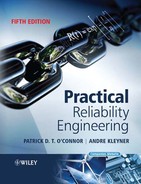Preface to the Second Edition
I have received much helpful criticism of the first edition of my book since it appeared in 1981. Whilst the reviews have generally not been unfavourable, critics have pointed out that, despite the title, the book was not quite practical enough in some areas. I have also come to realize this through my own work, particularly on the application of mathematical modelling and statistics to reliability problems. Consequently, much of the revision for the second edition has been to add to what I consider to be the practical aspects of management and engineering for reliability.
I have added to the sections on reliability prediction, demonstration and measurement, to explain and to stress the fundamental and considerable uncertainty associated with attempts to quantify and forecast a property of engineered products which is inherently non-deterministic. I believe that when people involved in reliability work manage to unshackle themselves from the tyranny of the ‘numbers game’ the way is cleared for the practical engineering and management approaches that are the only ways to achieve the highly reliable products demanded by the markets of today. I have not removed the descriptions of the methods for quantifying reliability, since I believe that, when these are applied with commonsense and understanding of their inherent limitations, they can help us to solve reliability problems and to design and make better products.
I have added three new chapters, all related to the practical aspects.
The first edition described how to analyse test data, but included little on how to test. I have therefore written a new chapter on reliability testing, covering environmental and stress testing and the integration of reliability and other development testing. I am indebted to Wayne Tustin for suggesting this and for his help and advice on this subject.
The quality of manufacture is obviously fundamental to achieving high reliability. This point was made in the first edition, but was not developed. I have added a complete chapter on quality assurance (QA), as well as new material on integrated management of reliability and QA programmes.
Maintenance also affects reliability, so I have added a new chapter on maintenance and maintainability, with the emphasis on how they affect reliability, how reliability affects maintenance planning and how both affect availability.
I have also added new material on the important topic of reliability analysis for repairable systems. Harry Ascher, of the US Naval Research Laboratory, has pointed out that the reliability literature, including the first edition of my book, has almost totally ignored this aspect, leading to confusion and analytical errors. How many reliability engineers and teachers know that Weibull analysis of repairable system reliability data can be quite misleading except under special, unrealistic conditions? Thanks to Harry Ascher, I know now, and I have tried to explain this in the new edition.
I have also brought other parts of the book up to date, particularly the sections on electronic and software reliability.
The third reprint of the first edition included many corrections, and more corrections are made in this edition.
I am extremely grateful to all those who have pointed out errors and have helped me to correct them. Paul Baird of Hewlett Packard, Palo Alto, was particularly generous. Colleagues at British Aerospace, particularly Brian Collett, Norman Harris, Chris Gilders and Gene Morgan, as well as many others, also provided help, advice and inspiration.
Finally, my thanks go to my wife Ina for much patience, support and typing.
PATRICK O'CONNOR
1985
